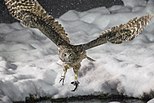Wildlife of Senria: Difference between revisions
(continued main page gutting) |
mNo edit summary |
||
| Line 1: | Line 1: | ||
{{Region icon Kylaris}} | {{Region icon Kylaris}} | ||
{{WIP}} | {{WIP}} | ||
{{multiple image|perrow = 2|total_width=325 | |||
| align = right | |||
| image1 = Japanese Macaque Fuscata Image 370 (cropped).jpg | |||
| image2 = Vulpes vulpes laying in snow.jpg | |||
| image3 = Racoon dog face.jpg | |||
| image4 = Sika Deer (73772293).jpeg | |||
| image5 = Blakiston's fish owl.jpg | |||
| image6 = Grue du Japon DSCF 1353.jpg | |||
| image7 = Achalinus formosanus formosanus close-up with tongue extended.jpg | |||
| image8 = Kuhaku kuchi benii.JPG | |||
| footer = Senria is host to a wide variety of fauna. | |||
}} | |||
Senria is the native home of between 4,000 and 6,000 species of {{wp|plant}}. The country's north is dominated by a mixture of both {{wp|deciduous}} and {{wp|evergreen}} {{wp|Broad-leaved tree|broad-leaved trees}} such as the {{wp|Ulmus davidiana var. japonica|Senrian elm}}, {{wp|Aucuba japonica|spotted laurel}}, {{wp|Zelkova serrata|keyaki}}, {{wp|Fagus crenata|Senrian beech}}, {{wp|Cleyera japonica|sakaki}}, {{wp|Quercus acuta|Senrian evergreen oak}}, and {{wp|Quercus myrsinifolia|Shangean ring-cupped oak}}. At higher altitudes and in the country's south, by contrast, forests are dominated more by {{wp|Conifer|conifers}} including the {{wp|Chamaecyparis obtusa|hinoki cypress}}, {{wp|Tsuga diversifolia|southern Senrian hemlock}}, {{wp|Cryptomeria|Senrian cedar}}, {{wp|Picea jezoensis|Yuusuu spruce}}, {{wp|Pinus densiflora|Senrian red pine}}, and {{wp|Pinus thunbergii|Senrian black pine}}. The country's national tree is the {{wp|Acer palmatum|Senrian maple}}. Flowering and fruiting plants native to Senria include {{wp|Prunus mume|plums}}, {{wp|Prunus subg. Cerasus|cherries}}, {{wp|Castanea crenata|chestnuts}}, {{wp|Azalea|azaleas}}, {{wp|Camellia japonica|camellias}}, {{wp|Wisteria floribunda|wisterias}}, {{wp|Iris ensata|irises}} and {{wp|Chrysanthemum|chrysanthemums}}. Important or famous food crops originating in Senria include the {{wp|Adzuki bean|adzuki vine}}, {{wp|Oenanthe javanica|water celery}}, {{wp|wasabi}}, and edible seaweeds such as {{wp|Pyropia tenera|nori}} and {{wp|Hijiki|hiziki}}; the country is also famous for its edible mushrooms, such as the highly-prized {{wp|Shiitake|siitake}} and {{wp|Matsutake|matutake}} mushrooms. | Senria is the native home of between 4,000 and 6,000 species of {{wp|plant}}. The country's north is dominated by a mixture of both {{wp|deciduous}} and {{wp|evergreen}} {{wp|Broad-leaved tree|broad-leaved trees}} such as the {{wp|Ulmus davidiana var. japonica|Senrian elm}}, {{wp|Aucuba japonica|spotted laurel}}, {{wp|Zelkova serrata|keyaki}}, {{wp|Fagus crenata|Senrian beech}}, {{wp|Cleyera japonica|sakaki}}, {{wp|Quercus acuta|Senrian evergreen oak}}, and {{wp|Quercus myrsinifolia|Shangean ring-cupped oak}}. At higher altitudes and in the country's south, by contrast, forests are dominated more by {{wp|Conifer|conifers}} including the {{wp|Chamaecyparis obtusa|hinoki cypress}}, {{wp|Tsuga diversifolia|southern Senrian hemlock}}, {{wp|Cryptomeria|Senrian cedar}}, {{wp|Picea jezoensis|Yuusuu spruce}}, {{wp|Pinus densiflora|Senrian red pine}}, and {{wp|Pinus thunbergii|Senrian black pine}}. The country's national tree is the {{wp|Acer palmatum|Senrian maple}}. Flowering and fruiting plants native to Senria include {{wp|Prunus mume|plums}}, {{wp|Prunus subg. Cerasus|cherries}}, {{wp|Castanea crenata|chestnuts}}, {{wp|Azalea|azaleas}}, {{wp|Camellia japonica|camellias}}, {{wp|Wisteria floribunda|wisterias}}, {{wp|Iris ensata|irises}} and {{wp|Chrysanthemum|chrysanthemums}}. Important or famous food crops originating in Senria include the {{wp|Adzuki bean|adzuki vine}}, {{wp|Oenanthe javanica|water celery}}, {{wp|wasabi}}, and edible seaweeds such as {{wp|Pyropia tenera|nori}} and {{wp|Hijiki|hiziki}}; the country is also famous for its edible mushrooms, such as the highly-prized {{wp|Shiitake|siitake}} and {{wp|Matsutake|matutake}} mushrooms. | ||
Latest revision as of 15:04, 12 March 2024
This article is incomplete because it is pending further input from participants, or it is a work-in-progress by one author. Please comment on this article's talk page to share your input, comments and questions. Note: To contribute to this article, you may need to seek help from the author(s) of this page. |
Senria is the native home of between 4,000 and 6,000 species of plant. The country's north is dominated by a mixture of both deciduous and evergreen broad-leaved trees such as the Senrian elm, spotted laurel, keyaki, Senrian beech, sakaki, Senrian evergreen oak, and Shangean ring-cupped oak. At higher altitudes and in the country's south, by contrast, forests are dominated more by conifers including the hinoki cypress, southern Senrian hemlock, Senrian cedar, Yuusuu spruce, Senrian red pine, and Senrian black pine. The country's national tree is the Senrian maple. Flowering and fruiting plants native to Senria include plums, cherries, chestnuts, azaleas, camellias, wisterias, irises and chrysanthemums. Important or famous food crops originating in Senria include the adzuki vine, water celery, wasabi, and edible seaweeds such as nori and hiziki; the country is also famous for its edible mushrooms, such as the highly-prized siitake and matutake mushrooms.
The country also exhibits great diversity in animal life. Mammal species native to Senria include the Yuusuu brown bear, red fox, tanuki, Senrian marten, Steller's sea lion, sika deer, Senrian serow, Isotama flying fox, and Senrian macaque. Native species of bird include the golden eagle, Senrian sparrowhawk, Blakiston's fish owl, red-crowned crane, Senrian woodpecker, green pheasant, Austral turtledove, and Senrian quail. Reptiles native to Senria include the loggerhead sea turtle, Senrian pond turtle, Shangean sea snake, Isotaman habu, Senrian pit viper, Isigaki's odd-scaled snake, and common lizard. Senria is home to at least forty species of amphibian; the most famous of these is the Senrian giant salamander, the third-largest species of salamander in the world. With regards to insects, Senria has more than 300 species of butterfly, more than 1,000 species of moth, and 190 species of dragonfly; the country is also known for its cicadas, fireflies, crickets, and hornets. Senria is home to more than 3,000 species of fish, including the ayu, common carp, cherry salmon, Senrian taimen, red seabream, whitespotted conger, Lumine saury, Lumine bluefin tuna, and Senrian sea bass.








